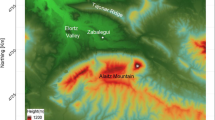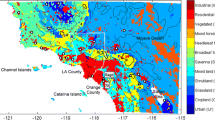Abstract
This paper addresses the problem of estimating surface fluxes at large scale over heterogeneous terrain, and the corresponding determination of effective surface parameters. Two kinds of formulation are used to calculate the fluxes of sensible and latent heat: the basic diffusion equations (Ohm's law type) and the Penman-Monteith equations. The strategy explored is based upon the principle of flux conservation, which stipulates that the average flux over a large area is simply the area-weighted mean of the contributions from the different patches making up the area. We show that the application of this strategy leads to different averaging schemes for the surface parameters, depending on the type of flux (latent heat, sensible heat) and on the type of formulation used to express the flux. It appears that the effective value of a given parameter must be appraised for each individual application, because it is not unique, but differs according to the magnitude being conserved and the equation used to express this magnitude. Numerical simulations are carried out to test over contrasted areas the aggregation procedures obtained. The areal fluxes estimated from these effective parameters, together with the areal fluxes calculated by means of a simple areal averaging of the parameters, are compared to the “true’ average fluxes, calculated as area-weighted means of the elementary fluxes. The aggregation procedures obtained prove to be much more accurate for estimating areal fluxes and for closing the energy balance equation than those based upon simple areal averaging of the parameters.
Similar content being viewed by others
References
Avissar, R.: 1992, ‘Conceptual Aspects of a Statistical-Dynamical Approach to Represent Landscape Subgrid-Scale Heterogeneities in Atmospheric Models’,J. Geophys. Res. 97, 2729–2742.
Blyth, E. M., Dolman, A. J., and Wood, N.: 1993, ‘Effective Resistance to Sensible and Latent Heat Flux in Heterogeneous Terrain’,Q. J. R. Meteorol., Soc. 119, 423–442.
Chehbouni, A., Njoku, E. G., Lhomme, J. P., and Kerr, Y. H.: 1994, ‘Aggregation Techniques to Estimate Hydrological Fluxes Controlling Parameters: Application to Remotely Sensed Surface Temperature. Presented in Workshop on Thermal Remote Sensing of the Energy and Water Balance over Vegetation in Conjunction with other Sensors’, La Londe les Maures, France, 20–30 September 1993.
Claussen, M.: 1991, ‘Estimation of, Areally-Averaged Surface Fluxes’,Boundary-Layer Meteorol.54 387–410.
Dolman, A. J.: 1992, ‘A Note on Areally-Averaged Evaporation and the Value of the Effective Surface Conductance’,J. Hydrol. 138, 583–589.
Henderson-Sellers, A. and Pitman, A. J.: 1992, ‘Land-Surface Schemes for Future Climate Models: Specification, Aggregation and Heterogeneity’,J. Geophys. Res. 97, 2687–2696.
Klaassen, W.: 1992, ‘Average Fluxes from Heterogeneous Vegetated Regions’,Boundary-Layer Meteorol. 58, 329–354.
Koster, R. D. and Suares, M. J.: 1992, ‘Modeling the Land Surface Boundary in Climate Models as a Composite of Independent Vegetation Stands’,J. Geophys. Res. 97, 2697–2715.
Lhomme, J. P.: 1992, ‘Energy Balance of Heterogeneous Terrain: Averaging the Controlling Parameters’,Agric. For. Meteorol. 61, 11–21.
Mason, P. J.: 1988, ‘The Formation of Areally-Averaged Roughness Lengths’Q. J. R. Meteorol. Soc. 114, 399–420.
McNaughton, K. G.: 1994, ‘Effective Stomatal and Boundary-Layer Resistances of Heterogeneous Surfaces’,Plant, Cell and Environment, (in press).
Monteith, J. L.: 1963, ‘Gas Exchange in Plant Communities’, in: L. T. Evans (ed.),Environmental Control of Plant Growth, Academic Press, New York, pp. 95–112.
Raupach, M. R.: 1991, ‘Vegetation-Atmosphere Interaction in Homogeneous and Heterogeneous Terrain: Some Implications of Mixed-Layer Dynamics’,Vegetatio 91, 105–120.
Raupach, M. R.: 1993, ‘The Averaging of Surface Flux Densities in Heterogeneous Landscapes’, in: H. J. Bolle, R. A. Feddes and J. D. Kalma (eds.),Exchange Processes at the Land Surface for a Range of Space and Time Scales (Proceedings of the Yokohama Symposium, July 1993).IAHS Publ. No. 212.
Short, D. L., Crapper, P. F., and Kalma, J. D.: 1993, ‘Moving Between Scales in Surface Hydrology: The Need to Reformulate Physics’, in: H. J. bolle, R. A. Feddes and J. D. Kalma (eds.),Exchange Processes at the Land Surface for a Range of Space and Time Scales (Proceedings of the Yokohama Symposium, July 1993).IAHS Publ. No. 212.
Shuttleworth, W. J.: 1988, ‘Macrohydrology: The New Challenge for Process Hydrology’,J. Hydrol. 100, 31–56.
Wieringa, J.: 1986, ‘Roughness-Dependent Geographical Interpolation of Surface Wind Speed Averages’,Q. J. R. Meteorol. Soc. 112, 867–889.
Author information
Authors and Affiliations
Rights and permissions
About this article
Cite this article
Lhomme, J.P., Chehbouni, A. & Monteny, B. Effective parameters of surface energy balance in heterogeneous landscape. Boundary-Layer Meteorol 71, 297–309 (1994). https://doi.org/10.1007/BF00713743
Revised:
Issue Date:
DOI: https://doi.org/10.1007/BF00713743




